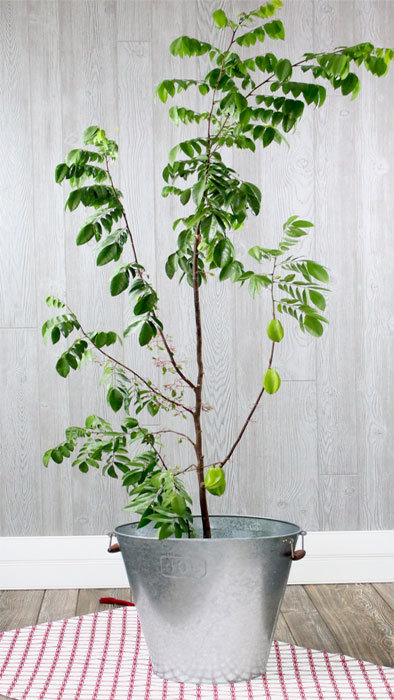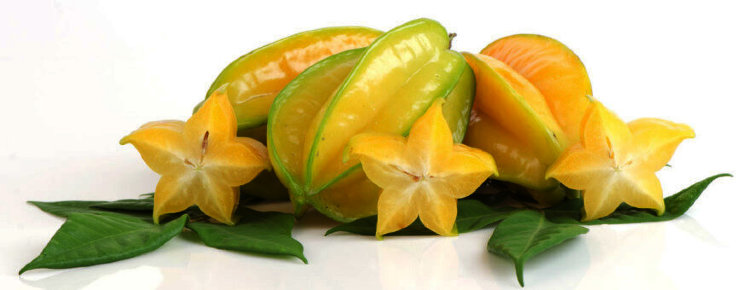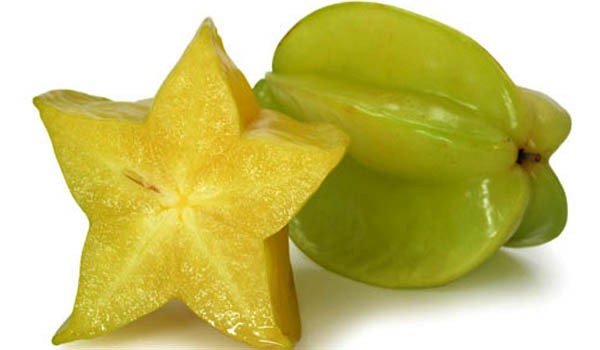- Overview
Common name: Carambola, Starfruit, Five-finger Botanical name: Averrhoa carambola Avg Height X Width: 12' x 12' Family: Oxalidaceae Origin: Southeast Asia Season: August - March Damage temp: 26-28 F Carambola/Star Fruit Tree Grafted in a 3 Gallon Container. Carambola's are small symmetrical trees that fruit very prolifically. They are commonly eaten fresh, in salads, as garnishes and in drinks. The fruit have a sweet citrus like flavor that is both delicious and refreshing. They are also great in jams and as a fruit beverage. A mature star fruit can produce up to 200 lbs. of fruit a year! This exciting yellow fruit is shaped just like a star when sliced makes a great decoration in salads and is extremely sweet. Tree produces 2-3 crops a year and is extremely prolific.
Description
Origin and Distribution
Varieties
Climate
Soil
Propagation
Culture
Harvesting And Yield
Keeping Quality
Pests and Diseases
Food Uses
Other Uses
Medicinal Uses
A curious, attractive fruit of the Oxalidaceae, the carambola, Averrhoa carambola L., has traveled sufficiently to have acquired a number of regional names in addition to the popular Spanish appelation which belies its Far Eastern origin. In the Orient, it is usually called balimbing, belimbing, or belimbing manis ("sweet belimbing"), to distinguish it from the bilimbi or belimbing asam, A. bilimbi L. In Ceylon and India, the carambola has the alternate names of kamaranga, kamruk, or other variants of the native kamrakh. In Vietnam, it is called khe, khe ta, or similar terms; in Kampuchea, spu; in Laos, nak fuang, or the French name, carambolier; in Thailand, ma fueang. Malayans may refer to it as belimbing batu, belimbing besi, belimbing pessegi, belimbing sayur, belimbing saji, kambola, caramba, or as "star fruit". Australians use the descriptive term, five corner; in Guam, it is bilimbines; to the Chinese, it is yang-táo. Early English travelers called it Chinese, or Coromandel gooseberry, or cucumber tree. In Guyana, it is five fingers; in the Dominican Republic, it is vinagrillo; in Haiti, zibline; in some of the French Antilles, cornichon; in El Salvador, pepino de la India; in Surinam, blimbing legi or fransman-birambi; Costa Rica, tiriguro; in Brazil, camerunga or caramboleiro, or limas de Cayena; in Mexico, carambolera or caramboler or árbol de pepino; in Trinidad, it may be called coolie tamarind. Venezuelans call it tamarindo chino or tamarindo dulce.
Description
The carambola tree is slow-growing, short-trunked with a much-branched, bushy, broad, rounded crown and reaches 20 to 30 ft (6-9 m) in height. Its deciduous leaves, spirally arranged, are alternate, imparipinnate, 6 to 10 in(15-20 cm) long, with 5 to 11 nearly opposite leaflets, ovate or ovate-oblong, 1 1/2 to 3 1/2 in (3.8-9 cm) long; soft, medium-green, and smooth on the upper surface, finely hairy and whitish on the underside. The leaflets are sensitive to light and more or less inclined to fold together at night or when the tree is shaken or abruptly shocked. Small clusters of red-stalked, lilac, purple-streaked, downy flowers, about 1/4 in (6 mm) wide, are borne on the twigs in the axils of the leaves. The showy, oblong, longitudinally 5- to 6-angled fruits, 2 1/2 to 6 in (6.35-15 cm) long and up to 3 1/2 (9 cm) wide, have thin, waxy, orange-yellow skin and juicy, crisp, yellow flesh when fully ripe. Slices cut in cross-section have the form of a star. The fruit has a more or less pronounced oxalic acid odor and the flavor ranges from very sour to mildly sweetish. The so-called "sweet" types rarely contain more than 4% sugar. There may be up to 12 flat, thin, brown seeds 1/4 to 1/2 in (6-12.5 mm) long or none at all.
Origin and Distribution
The carambola is believed to have originated in Ceylon and the Moluccas but it has been cultivated in southeast Asia and Malaysia for many centuries. It is commonly grown in the provinces of Fukien, Kuangtung and Kuangsi in southern China, in Taiwan and India. It is rather popular in the Philippines and Queensland, Australia, and moderately so in some of the South Pacific islands, particularly Tahiti, New Caledonia and Netherlands New Guinea, and in Guam and Hawaii. There are some specimens of the tree in special collections in the Caribbean islands, Central America, tropical South America, and also in West Tropical Africa and Zanzibar. Several trees have been growing since 1935 at the Rehovoth Research Station in Israel. In many areas, it is grown more as an ornamental than for its fruits. It was introduced into southern Florida before 1887 and was viewed mainly as a curiosity until recent years when some small groves have been established and the fruits have been used as "conversation pieces" to decorate gift shipments of citrus fruits, and also, in clear-plastic-wrapped trays, have been appearing in the produce sections of some supermarkets. One fruit-grower and shipper now has 50 acres (20 ha) planted but suggests that other prospective growers be cautious as the market may remain limited. Shipments go mainly to Vancouver, Quebec, Cleveland, and Disneyworld. Small amounts are sold locally.
Varieties
There are 2 distinct classes of carambola–the smaller, very sour type, richly flavored, with more oxalic acid; the larger, so-called "sweet" type, mild-flavored, rather bland, with less oxalic acid. In 1935, seeds from Hawaii were planted at the University of Florida's Agricultural Research and Education Center in Homestead. A selection from the resulting seedlings was vegetatively propagated during the 1940's and 1950's and, in late 1965, was officially released under the name 'Golden Star' and distributed to growers. The fruit is large, deeply winged, decorative, and mildly subacid to sweet. Furthermore, this cultivar shows the least minor-element deficiency in alkaline soil, and even isolated trees bear well and regularly without cross-pollination. Several cultivars from Taiwan are being grown at the United States Department of Agriculture's Subtropical Horticulture Research Unit in Miami, including 'Mih Tao' (P. I. No. 272065) introduced in 1963, also 'Dah Pon' and 'Tean Ma' and others identified only by numbers, and Fwang Tung' brought from Thailand by Dr. R J. Knight in 1973. There are certain "lines" of carambola, such as 'Newcomb', 'Thayer' and 'Arkin' being grown commercially in southern Florida. Some cultivars and seedlings bear flowers with short styles, others only flowers with long styles, a factor which affects self- and cross-pollination.
Climate
The carambola should be classed as tropical and sub-tropical because mature trees can tolerate freezing temperatures for short periods and sustain little damage at 27º F (-2.78º C). In Florida, the tree survives in sheltered sites as far north as St. Petersburg on the west coast and Daytona Beach on the east. It thrives up to an elevation of 4,000 ft (1,200 m) in India. In an interior valley of Israel, all trees succumbed to the prevailing hot, dry winds. The carambola needs moisture for best performance and ideally rainfall should be fairly evenly distributed all year. In Australia, it is claimed that fruit quality and flavor are best where annual rainfall is 70 in (180 cm) or somewhat more.
Soil
Not too particular as to soil, the carambola does well on sand, heavy clay or limestone, but will grow faster and bear more heavily in rich loam. It is often chlorotic on limestone. It needs good drainage; cannot stand flooding.
Propagation
The carambola is widely grown from seed though viability lasts only a few days. Only plump, fully developed seeds should be planted. In damp peat moss, they will germinate in one week in summer, require 14 to 18 days in winter. The seedlings are transplanted to containers of light sandy loam and held until time to set out. They are very tender and need good care. Seedlings are highly variable. Air-layering has been practiced and advocated. However, root formation is slow and later performance is not wholly satisfactory. Inarching is successful in India, shield-budding in the Philippines and the Forkert method in Java. Trees can be top-worked by bark-grafting, a popular technique in Java. For mass production, side-veneer grafting of mature, purplish wood, onto carambola seedlings gives best results for most workers. The rootstocks should be at least 1 year old and 3/8 to 5/7 in (1-1.5 cm) thick. One Florida farmer prefers cleft-grafting of green budwood and has 90% success. Grafted trees will fruit in 10 months from the time of planting out. Mature trees can be top-worked by bark-grafting.
Culture
The tree needs full sun. A spacing of 20 ft (6 m) has been advocated but if the trees are on good soil no less than 30 ft (9 m) should be considered. At the Research Center in Homestead, trees 8 to 10 ft (2.4-3 m) high respond well to 1 lb (0.5 kg) applications of N, P, K, Mg in the ratio of 6-6-6-3 given 3 to 4 times per year. If chlorosis occurs, it can be corrected by added iron, zinc and manganese. Some advisers recommend minor-element spraying 4 times during the year if the trees are on limestone soils. Moderate irrigation is highly desirable during dry seasons. Heavy rains during blooming season interfere with pollination and fruit production. Interplanting of different strains is usually necessary to provide cross-pollination and obtain the highest yields.
Harvesting And Yield
In India, carambolas are available in September and October and again in December and January. In Malaya, they are produced all the year. In Florida, scattered fruits are found through the year but the main crop usually matures from late summer to early winter. Some trees have fruited heavily in November and December, and again in March and April. There may even be three crops. Weather conditions account for much of the seasonal variability. The fruits naturally fall to the ground when fully ripe. For marketing and shipping they should be hand-picked while pale-green with just a touch of yellow. Trees that receive adequate horticultural attention have yielded 100 to 250 or even 300 lbs (45-113-136 kg) of fruit.
Keeping Quality
Carambolas have been shipped successfully without refrigeration from Florida to northern cities in avocado lugs lined and topped with excelsior. The fruits are packed solidly, stem-end down, at a 45º angle, the flanges of one fruit fitting into the "V" grooves of another. Of course, they cannot endure rough handling. In storage trials at Winter Haven, Florida, carambolas picked when showing the first signs of yellowing kept in good condition for 4 weeks at 50º F (10º C); 3 weeks at 60º F (15.56º C); 2 weeks at 70º F (21.1º C). Waxing extends storage life and preserves the vitamin value.
Pests and Diseases
The carambola is relatively pest-free except for fruit flies. In Malaya, fruit flies (especially Dacus dorsalis) are so troublesome on carambolas that growers have to wrap the fruits on the tree with paper. Experimental trapping, with methyl eugenol as an attractant, has reduced fruit damage by 20%. In Florida, a small stinkbug causes superficial blemishes and a black beetle attacks overripe fruits. Reniform nematodes may cause tree decline. Anthracnose caused by Colletotrichum gloeosporioides may be a problem in Florida, and leaf spot may arise from attack by Phomopsis sp., Phyllosticta sp. or Cercospora averrhoae. Cercospora leaf spot is reported also from Malaya, Ceylon, China and may occur in the Philippines as well. A substance resembling sooty mold makes many fruits unmarketable in summer.
Food Uses
Ripe carambolas are eaten out-of-hand, sliced and served in salads, or used as garnish on avocado or seafood. They are also cooked in puddings, tarts, stews and curries. In Malaya, they are often stewed with sugar and cloves, alone or combined with apples. The Chinese cook carambolas with fish. Thais boil the sliced green fruit with shrimp. Slightly underripe fruits are salted, pickled or made into jam or other preserves. In mainland China and in Taiwan, carambolas are sliced lengthwise and canned in sirup for export. In Queensland, the sweeter type is cooked green as a vegetable. Cross-sections may be covered with honey, allowed to stand overnight, and then cooked briefly and, put into sterilized jars. Some cooks add raisins to give the product more character. A relish may be made of chopped unripe fruits combined with horseradish, celery, vinegar, seasonings and spices. Indian experimenters boiled horizontal slices with 3/4 of their weight in sugar until very thick, with a Brix of 68º. They found that the skin became very tough, the flavor was not distinctive, and the jam was rated as only fair. Sour fruits, pricked to permit absorption of sugar and cooked in sirup, at first 33º Brix, later 72º, made an acceptable candied product though the skin was still tough. The ripe fruits are sometimes dried in Jamaica. Carambola juice is served as a cooling beverage. In Hawaii, the juice of sour fruits is mixed with gelatin, sugar, lemon juice and boiling water to make sherbet. Filipinos often use the juice as a seasoning. The juice is bottled in India, either with added citric acid (1% by weight) and 0.05 % potassium metabisulphite, or merely sterilizing the filled bottles for 1/2 hr in boiling water. To make jelly, it is necessary to use unripe "sweet" types or ripe sour types and to add commercial pectin or some other fruit rich in pectin such as green papaya, together with lemon or lime juice. The flowers are acid and are added to salads in Java; also, they are made into preserves in India. The leaves have been eaten as a substitute for sorrel.
Food Value Per 100 g of Edible Portion (Flesh)*
Ripening and storage studies were conducted at the Florida Citrus Experiment Station at Lake Alfred in 1966. They found quite a difference in the acid make-up of mature green and mature yellow carambolas. Fresh mature green fruits of 'Golden Star' were found to have a total acid content of 12.51 mg/g consisting of 5 mg oxalic, 4.37 tartaric, 1.32 citric, 1.21 malic, 0.39 a-ketoglutaric, 0.22 succinic, and a trace of fumaric. Mature yellow fruits had a total acid content of 13 mg/g, made up of 9.58 mg oxalic, 0.91 tartaric, 2.20 a-ketoglutaric, 0.31 fumaric. In 1975, 16 carambola selections and 2 named cultivars were assayed at the United States Citrus and Subtropical Products Laboratory, Winter Haven, Florida. Preliminary taste tests ranked 'No. 17, 'No. 37', 'No. 42' and 'Tean Ma' as preferred. In a later test, 'Dah Pon' was ranked above 'Tean Ma'. 'No. 17' (º Brix 9.9) was described as "sweet, good and apple-like". 'No. 37' (º Brix 6.7), as "sour and sweet". 'No. 42' (º Brix 8.3), as "sour, tart and apple-like". 'Dah Pon' (º Brix 8.0), as "good and mild". 'Tean Ma (º Brix 7.2), as "sweet, good and mild". Analyses showed that these 5 were among those with relatively high ascorbic acid content–'No. 17, 30 mg; 'Dah Pon', 30 mg; 'No. 37', 37 mg; 'No. 42', 37 mg; and 'Tean Ma', 41 mg. 'No. 40' had 43 mg and 'No. 11', 50 mg, whereas 'M-23007' had only 14 mg and 'No. 10' only 17 mg. Oxalic acid content of the 18 selections and cultivars ranged from 0.039 mg to 0.679 mg and 4 of the preferred carambolas were in the lower range as follows: 'No. 17', 0.167; 'Dah Pon', 0.184; 'Tean Ma', 0.202; 'No. 42', 0.276 mg, but 'No. 37', with 0.461 was 3rd from the highest of all. Puerto Rican technologists found the oxalic acid content of ripe carambolas to average 0.5 g per 100 ml of juice, the acid being mostly in the free state. They likened the juice to rhubarb juice and advised that physicians be informed of this because there are individuals who may be adversely affected by ingestion of even small amounts of oxalic acid or oxalates. Other investigators have presumed the oxalic acid in fully ripe carambolas to be precipitated as calcium oxalate or in solution as neutral salts. The health risk needs further study.
Food Value Per 100 g of Edible Portion*
Calories 35.7
Moisture 89.0-91.0 g
Protein 0.38 g
Fat 0.08 g
Carbohydrates 9.38 g
Fiber 0.80-0.90 g
Ash 0.26-0.40 g
Calcium 4.4-6.O mg
Phosphorus 15.5-21.0 mg
Iron 0.32-1.65 mg
Carotene 0.003-0.552 mg
Thiamine 0.03-0.038 mg
Riboflavin 0.019-0.03 mg
Niacin 0.294-0.38 mg
Ascorbic Acid* 26.0-53.1 mg
* According to analyses made in Cuba and Honduras.
Other Uses
The acid types of carambola have been used to clean and polish metal, especially brass, as they dissolve tarnish and rust. The juice will also bleach rust stains from white cloth. Unripe fruits are used in place of a conventional mordant in dyeing.
Wood: Carambola wood is white, becoming reddish with age; close-grained, medium-hard. It has been utilized for construction and furniture.
Medicinal_Uses
In India, the ripe fruit is administered to halt hemorrhages and to relieve bleeding hemorrhoids; and the dried fruit or the juice may be taken to counteract fevers. A conserve of the fruit is said to allay biliousness and diarrhea and to relieve a "hangover" from excessive indulgence in alcohol. A salve made of the fruit is employed to relieve eye afflictions. In Brazil, the carambola is recommended as a diuretic in kidney and bladder complaints, and is believed to have a beneficial effect in the treatment of eczema. In Chinese Materia Medica it is stated, "Its action is to quench thirst, to increase the salivary secretion, and hence to allay fever." A decoction of combined fruit and leaves is drunk to overcome vomiting. Leaves are bound on the temples to soothe headache. Crushed leaves and shoots are poulticed on the eruptions of chicken-pox, also on ringworm. The flowers are given as a vermifuge. In southeast Asia, the flowers are rubbed on the dermatitis caused by lacquer derived from Rhus verniciflua Stokes. Burkill says that a preparation of the inner bark, with sandalwood and Alyxia sp., is applied on prickly heat. The roots, with sugar, are considered an antidote for poison. Hydrocyanic acid has been detected in the leaves, stems and roots. A decoction of the crushed seeds acts as a galactagogue and ernmenagogue and is mildly intoxicating. The powdered seeds serve as a sedative in cases of asthma and colic. - Features
weight: 9.99 lbs : - ReviewsThere is no reviews yet...Be the first!
Be the first to write a review of this product!









